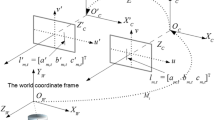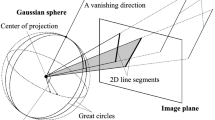Abstract
This paper describes a system for structure from motion using vanishing points and three-dimensional lines extracted from omni-directional video sequences. To track lines, we use a novel dynamic programming approach to improve ambiguity resolution, and we use delayed states to aid in the initialization of landmarks. By reobserving vanishing points we get direct measurements of the robot’s three-dimensional attitude that are independent of its position. Using vanishing points simplifies the representation since parallel lines share the same direction states. We show the performance of the system in various indoor and outdoor environments and include comparisons with independent two-dimensional reference maps for each experiment .
Similar content being viewed by others
References
Antone M, Teller S (2000) Automatic recovery of relative camera rotations for urban scenes. In: International Conference on Computer Vision and Pattern Recognition, Vol II, pp 282–289
Antone ME (2001) Robust camera pose recovery using stochastic geometry. PhD thesis, Massachusetts Institute of Technology
Bar-Shalom Y, Fortmann TE (1988) Tracking and data association. Academic Press Limited, San Diego, CA, 1988
Bosse MC, Newman PM, Leonard JJ, Soika M, Feiten W, Teller S (2003) An atlas framework for scalable mapping. Proc. IEEE Int Conf Robot Autom (Forthcoming)
Castellanos JA, Montiel JMM, Neira J, Tardos JD (1999) The SPmap: a probabilistic framework for simultaneous localization and map building. IEEE Trans Robot Autom 15(5):948–952
Chiuso A, Favaro P, Jin H, Soatto S (2002) Structure from motion causally integrated over time. IEEE Trans Patt Anal Machine Intel 24(4):523–535
Cormen T, Leiserson C, Rivest R (2001) Introduction to algorithms. MIT Press; http://www.amazon.com/exec/obidos/ASIN/0262032937/ref%3Dnosim/necresearch-20/103-1702329-3847865
Davison AJ (1998) Mobile robot navigation using active vision. PhD thesis, University of Oxford
Dissanayake MWMG, Newman P, Durrant-Whyte HF, Clark S, Csorba M (1999) An experimental and theoretical investigation into simultaneous localization and map building. In: Sixth International Symposium on Experimental Robotics, pp 265–274
Faugeras O, Luong Q-T, Papadopoulo T (2001) The geometry of multiple images. MIT Press; http://www.amazon.com/exec/obidos/tg/detail/-/0262062208/qid=1057849899/sr=1-2/ref=sr_1_2/103-1702329-3847865?v=glance&s=books
Guivant J, Nebot E (2001) Optimization of the simultaneous localization and map building algorithm for real time implementation. IEEE Trans Robot Autom 17(3):242–257
Hartley RI, Zisserman A (2001) Multiple view geometry in computer vision. Cambridge University Press [ISBN: 0521623049]
Leonard JJ, Rikoski RJ, Newman PM, Bosse M (2002) Mapping partially observable features from multiple uncertain vantage points. Int J Robot Res 21(10):943–975
Lozano-Pérez T (1989) Foreword. In: Cox IJ, Wilfong GT (eds.) Autonomous robot vehicles. Springer, Berlin
Marr D (1982) Vision. Freeman, New York
McLauchlan PF (2000) A batch/recursive algorithm for 3d scene reconstruction. In: International Conference on Computer Vision and Pattern Recognition, Hilton Head, SC, Vol 2, pp 738–743
Moutarlier P, Chatila R (1989) An experimental system for incremental environment modeling by an autonomous mobile robot. In: 1st International Symposium on Experimental Robotics, Montreal
Moutarlier P, Chatila R (1989) Stochastic multi-sensory data fusion for mobile robot location and environment modeling. In: 5th International Symposium on Robotics Research, pp 207–216
Smith R, Self M, Cheeseman P (1990) Estimating uncertain spatial relationships in robotics. In: Cox IJ, Wilfong GT (eds) Autonomous Robot Vehicles, pp 167–193. Springer-Verlag
Smith SM, Brady JM (1997) Susan – a new approach to low level image processing. Int J Comput Vision 23(1):45–78
Taylor CJ, Kriegman DJ (1995) Structure and motion from line segments in multiple images. IEEE Trans Pattern Anal Mach Intell 17(11):1021–1032
Taylor CJ (2000) Videoplus: a method for capturing the structure and appearance of immersive environments. In: Second Workshop on 3D Structure from Multiple Images of Large-scale Environments, pp 187–204
Teller S, Antone M, Bodnar Z, Bosse M, Coorg S (2001) Calibrated, registered images of an extended urban area. In: International Conference on Computer Vision and Pattern Recognition, Kauai, Hawaii, Vol 1, pp 813–820
Thrun S (2001) An online mapping algorithm for teams of mobile robots. Int J Robot Res 20(5):335–363
Triggs B, Zisserman A, Szeliski R (eds.) (1999) Vision algorithms, theory and practice: International Workshop on Vision. Springer, Berlin
Author information
Authors and Affiliations
Corresponding author
Rights and permissions
About this article
Cite this article
Bosse, M., Rikoski, R., Leonard, J. et al. Vanishing points and three-dimensional lines from omni-directional video. Vis Comput 19, 417–430 (2003). https://doi.org/10.1007/s00371-003-0205-3
Published:
Issue Date:
DOI: https://doi.org/10.1007/s00371-003-0205-3




